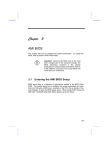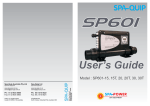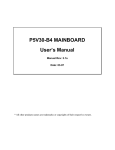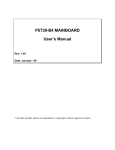Download Chapter 3
Transcript
Chapter 3 AMI BIOS This chapter tells how to configure the system by setting the BIOS parameters. 3.1 Entering the AMI BIOS Setup To enter the AMI BIOS Setup, press appears as shown below. . The AMI BIOS Setup Main Menu The AMI BIOS is in Windows form. You can use either the keyboard or a mouse to move between the items. To select among the Setup menu groups, use to highlight the selected group or simply click on the icon of the selected Setup menu. To select among the options, you can either use the arrow keys to move the highlight bar or simply click on the icon of the desired option. 3-1 AMI BIOS Utility After making your selection, press the selected menu option. You may press or double-click on the icon to open to perform the following: Resolve an address conflict due to an IRQ address assigned to multiple slots. For more information on IRQ assignment, see the section 3.2.3 (Chipset Features Setup). Return to the BIOS default settings if the PnP BIOS does not recognize the hardware modifications under Windows 95. To meet the PC market demands, ongoing hardware and software enhancements are done on the system. Therefore, it is possible that BIOS screens may be changed without notice. 3-2 AMI BIOS Utility 3.2 Setup Menu The figure below shows the Setup window. Use the arrow keys to highlight an option. 3.2.1 Standard Setup The following screen appears if you select options: Standard from the Setup You can input configuration values such as date, time and disk types in this menu. PRIMARY MASTER AND SLAVE/ SECONDARY MASTER AND SLAVE These parameters allow you to configure the hard disks and the IDE devices connected to your IDE connectors. To configure the hard disk connected to the master port of the primary IDE connector, select Primary Master and press . The following screen appears: 3-3 AMI BIOS Utility To configure the hard disk connected to the slave port of the primary IDE connector, select Primary Slave . The secondary IDE connector also supports two IDE devices. To configure the hard disk or the IDE device connected to the master port, select Secondary Master . Choose Secondary Slave to configure the device connected to the slave port. The following are the parameters that you need to set to configure your hard disks or the IDE devices: 3-4 AMI BIOS Utility Type This parameter lets you set the IDE device type that your system supports. The options are User , Auto , CD-ROM , Type 1-46 , and Not Installed . Select Auto to automatically configure the installed hard disk or IDE device. Select CD-ROM if you have a CD-ROM installed in your system. If you have an old type HDD installed, you may need to enter the HDD parameters manually. To do this, you must set this parameter toUser . Select Not Installed to bypass the function. LBA/Large Mode This enhanced IDE feature allows the system to use a hard disk with a capacity of more than 528 MB. This is made possible through the Logical Block Address (LBA) mode translation. Set the parameter toOff to disregard the feature. This parameter becomes non-configurable when the HDD Type parameter is set to Auto . Block Mode This function enhances disk performance depending on the hard disk in use. If enabled, it allows data transfers in block (multiple sectors) by increasing the data transfer rate to 256 bytes/cycle. However, if your hard disk does not support this function, set this parameter to Off . This parameter becomes non-configurable when the HDD Type parameter is set to Auto . 3-5 AMI BIOS Utility 32-bit Mode Enabling this parameter improves system performance by increasing the hard disk access to 32-bit mode. However, make sure that your hard disk supports this function before you enable the parameter. Otherwise, set this parameter to Off . PIO Mode Setting this parameter to On allows the system to use a faster hard disk drive. If your hard disk does not support the PIO mode feature, set this parameter to Off . This parameter becomes non-configurable when the HDD Type parameter is set to Auto . HARD DISK TYPES After you have set all the necessary parameters, press HDD drive parameters appears: Select your hard disk type. Press or After you have made your selection, press . A list of the to move among the selections. . If you cannot find your hard disk drive type on the list, select User . This allows you to enter the disk parameters manually. DATE/TIME To set the date and time, highlight following screen appears: 3-6 Date/Time and press . The AMI BIOS Utility Select the arrow keys to move among the items. Press or click on or to set the current time and date. Press or double-click on the Control menu box at the upper-left corner of the window. FLOPPY DRIVES A AND B To configure the first floppy drive, select Floppy A . The following values appear on screen: After selecting the proper setting, press Select Floppy floppy drive. . B and follow the same procedure to configure the second 3.2.2 Advanced CMOS Setup The following screen appears if you select the option Advanced from the Setup menu: 3-7 AMI BIOS Utility The first screen does not show all the parameters of the Advanced Configuration menu. To scroll down the rest of the parameters, press . Press or to highlight the desired parameter. 3-8 AMI BIOS Utility Do not change the settings of the Advanced Setup parameters if you are not a qualified technician. Doing so may cause fatal system failure. Quick Boot During boot up, the system performs power-on self test (POST) routines. Enable the parameter if you want to skip some POST routines during the boot process. Set this to Disabled to let the system perform all the POST routines and follow the specified boot-up sequence. Boot-up Sequence The boot-up sequence allows you to specify the system search sequence. The selections are C:, A:, CD-ROM , A:, C:, CD-ROM and CD-ROM, A:, C:. If you have a bootable CD-ROM installed, you may set the CD-ROM as the first priority. The default is A:, C:, CD-ROM. Boot-up Numlock Setting this parameter to On enables the numeric function of the numeric keypad. Set this parameter to Off to disable the function. Disabling the numeric function allows you to use the cursor control numeric keypad. The default setting is Off . 3-9 AMI BIOS Utility Floppy Drive Swap This parameter allows you to swap floppy drives. For example, if you have two floppy drives (A and B), you can assign the first drive as drive B and the second drive as drive A or vice-versa. Disable the parameter to bypass the function. The default is Disabled . Floppy Drive Seek When enabled, BIOS detects whether there is a floppy disk drive installed in the system. Disable the parameter to skip the function. Typematic Rate This parameter allows you to control the speed at which the system registers repeated keystrokes. System Keyboard Set this parameter to Presen t if there is a keyboard connected to the system. If none, select Absent . Primary Display This function specifies the VGA type in use. The selections areVGA/EGA, and Absent . The CGA 40 x 25, CGA 80 x 25, Mono, default setting is VGA/EGA . Password Check This parameter lets you set when to check for the password. When set to Always , a password prompt appears every time you turn on the computer and when you enter Setup. When set to Setup , the password prompt appears when you try to enter setup. The Optimal and Turbo default setting is Setup . OS/2 Compatible Mode Enable the parameter if your system is utilizing an OS/2 operating system and has a memory size of more than 64 MB. Otherwise, set this toDisabled . The default setting is Disabled . 3-10 AMI BIOS Utility Internal Cache This function lets you enable or disable the internal cache. External Cache This function lets you enable or disable the external cache. System BIOS Cacheable Enabling this parameter allows you to cache the system BIOS to further system performance. The default settings is Enabled. C000 ~ DC00, 16K Shadow These parameters are for shadowing expansion cards with ROM. You need to know the specific addresses that ROMs use to shadow the expansion cards before you set any of these parameters. If you do not know this information, enable all the ROM shadow settings. This ensures shadowing of any present ROMs and reduces the available memory . Select Cached if the data in the chosen addresses are already copied into RAM. The F000 and E000 addresses are exclusively shadowed for BIOS. 3-11 AMI BIOS Utility 3.2.3 Chipset Features Setup The Chipset Features Setup controls the board chipset settings. The controls for this menu are the same as for the previous screens. The Chipset Features Setup screen appears as follows. To scroll down the rest of the parameters, press highlight the desired parameter. . Use or to Memory Hole This option lets you assign the system memory area for ISA cards installed in your system to avoid memory conflicts. The available settings are 512~640K, 15~16M and Disabled . 3-12 AMI BIOS Utility DRAM Timing Setting The selections for this parameter are 60 ns, 70 ns, and Manual . If you select either 60 ns or 70 ns , the DRAM Timing subparameters become non-configurable since BIOS automatically sets the values. Select Manual if you want to specify your own parameter settings. FAST MA TO RAS# DELAY This option specifies the wait state between the master address (MA) and row address strobe (RAS) signals. The selections are 1 clock and 2 clocks . EDO:SPM READ BURST TIMING This parameter adjusts the read wait state for Extended Data Out (EDO) DRAM and Standard Page Mode (SPM) DRAM. Every time the CPU reads the second-level cache miss, it reads four continuous memory cycles on four continues addresses from the EDO and SPM cache. The selections for this parameter are x444/X444, X333/X444, X222/X333, and X3222/X333 . The value of X depends on the DRAM Lead-off Timing parameter setting. DRAM WRITE BURST TIMING This parameter adjusts the write wait state between the second-level and the DRAM cache. The second-level cache is processed through write-back method and each cache write process consists of four continuous cache write cycles. The parameter settings are X444, X333, and X222 . Faster DRAMs require shorter wait states. The value of X depends on the DRAM Lead-off Timing parameter setting. FAST RAS TO CAS DELAY This option specifies the wait state between the row address strobe (RAS) and column address strobe (CAS) signals. The available settings are3 clocks and 2 clocks . DRAM LEAD-OFF TIMING This option specifies the DRAM waiting time or the delay before data can be accessed. Some DRAMs may require a longer delay to access data. The selections are 11-7-3, 10-6-3, 11-7-4, and 10-6-4 . 3-13 AMI BIOS Utility REFRESH RAS# ASSERTION This function controls the number of clocks required to assert RAS# refresh cycles. The available settings are 4 clocks and 5 clocks . for FAST EDO PATH SELECT Enable this option to select a fast path for CPU to DRAM read cycles to minimize the lead-off time. This is applicable only for EDO DRAMs. For other DRAM types, we recommend that you set this to Disabled . SDRAM CAS# LATENCY This parameter controls the wait state between SDRAM row address strobe and SDRAM CAS signals. SDRAM RAS# TIMING This parameter controls the RAS# precharge, RAS# active-to-precharge time, and refresh-to-RAS# active signal delay. 8-bit I/O Recovery Time (Sysclk) This parameter allows you to set the response time of the 8-bit I/O devices connected to your system. The settings range from 1-8 SYSCLK and Disabled . 16-bit I/O Recovery Time (Sysclk) This parameter allows you to set the response time of the 16-bit I/O devices connected to your system. The settings range from 1-4 SYSCLK and Disabled . ISA Clock Divisor This option specifies the ISA bus clock divisor. PCICLK/4 and PCICLK/3 . The selections are Peer Concurrency Enable the parameter to allow the CPU to run secondary DRAM PCI master cycles to target PCI peer devices. Select Disabled to hold the CPU bus. The default setting is Disabled . 3-14 AMI BIOS Utility PCI 2.1 Compliant This parameter lets you enable or disable the PIIX3 PCI register passive release functions. When enabled , the PIIX3 controls the USB operation to make sure that the system complies with the PCI Revision 2.1 specification. Select Disabled to disregard the functions. USB Function Enabled This parameter lets you enable or disable the USB device(s) connected to your system, if any. The default is Disabled . The USB function shares INTD with PCI slot 4. Therefore, if you enable the USB function, only PCI cards that do not require IRQ, such as VGA, can be installed in slot 4. The PnP BIOS assigns an IRQ to VGA if the VGA requests for it. 3-15 AMI BIOS Utility 3.2.4 Power Management Setup To take advantage of the power-management feature, select Power Management from the Setup menu. The following screen appears: To scroll down the rest of the parameters, press highlight the desired parameter. . Use or to Power Management/APM This parameter enables or disables the advanced power-management function. 3-16 AMI BIOS Utility Instant On Time-out (Minutes) This parameter is configurable only if the Power Management/APM parameter is set to Instant On . This option lets you specify when to resume system power after being in power-saving mode for a certain period of time. Green Monitor Power-down State This function lets you set when to power down your green PC monitor. The options are Standby, Suspend, and Off . The default is Standby . Video Card Power-down Mode This option allows you to set when to power down your system display card. The card function returns to full power once the system resumes to normal mode. The selections are Standby, Suspend, and Disabled . The default setting is Standby. Hard Disk Power-down Mode This option lets you set when to “spin down your IDE hard disk. The disk returns to full speed once the system resumes to normal mode. The available settings are Standby, Suspend, and Disabled . The default setting is Suspend. Hard Disk Time-out (Minutes) This option lets you specify when to set the hard disk to the specified powerdown mode. The settings range from 1 ~ 15 Minutes and Disabled . Standby Time-out (Minutes) This function lets you set when to put the system into standby mode. In standby mode, the CPU clock slows down. Any event detected returns the system to full power. The settings range from 1 ~ 15 Minutes and Disabled . Suspend Time-out (Minutes) This function lets you set when to put the system into suspend mode. In suspend mode, the CPU clock stops. Any event detected returns the system to full power. The settings range from 1 ~15 Minutes and Disabled . 3-17 AMI BIOS Utility Slow Clock Ratio When the system enters the standby mode, the CPU clock starts to slow down. This parameter lets you set the “slow down” clock ratio. The selections are from 1:1, 1:2, 1:4, 1:8, 1:16, 1:32, 1:64, and 1:128 . Display Activity This function lets you check the activity of the monitor. When set to Monitor , any detected activity from the display resumes the system to normal mode. When set to Ignore , the power management function bypasses the display activities detected. IRQ 3, 4, 5, 7, 9, 10, 11, 12, 13, 14, and 15 These parameters enable or disable specific I/O devices as wake up events in the power management mode. Any activity detected from the enabled IRQs resets the power-management timers and returns the system to normal mode. 3-18 AMI BIOS Utility 3.2.5 PCI/PnP Setup The PCI/PNP Setup allows you to specify the setting for your PCI devices. The screen below appears on screen if you select PCI/PnP from the Setup menu. To scroll down the rest of the parameters, press highlight the desired parameter. . Use or to Plug-and-Play Aware O/S Enable this parameter only if you have a Plug-and-Play operating system, such as Windows 95. 3-19 AMI BIOS Utility PCI IRQ Priority Auto Setting Set this parameter to Yes to automatically set the appropriate available interrupt for each PCI slot. Select No if you prefer to manually set the interrupts. 1st, 2nd, 3rd, and 4th Available IRQ These parameters are configurable only if the PCI IRQ Priority Auto Setting parameter is set to No . When configurable, these let you specify the ranking of the interrupts which you can assign to the PCI devices installed in your system. PCI VGA Palette Snoop PCI devices support the palette snooping technique that enables the device to control access to their palette registers. Enable this parameter to activate the palette snooping function in the PCI VGA devices installed in the system. Check your VGA card manual for more information about his function. The default setting is Disabled . PCI IDE Card This function allows you to select the PCI slot(s) that you want to enable, if there is any offboard PCI IDE card present. Set this parameter toAuto to automatically configure the installed PCI card. PCI IDE Primary IRQ This parameter lets you assign an IRQ for the IDE device connected to your primary IDE connector. The options are INTA, INTB, INTC, INTD, Hardwired and Disabled . If the PCI IDE Card parameter is set to Auto , this parameter becomes non-configurable. PCI IDE Secondary IRQ This parameter lets you assign an IRQ for the IDE device connected to your secondary IDE connector. The options are INTA, INTB, INTC, INTD, Hardwired and Disabled . If the PCI IDE Card parameter is set to Auto , this parameter becomes non-configurable. 3-20 AMI BIOS Utility Reserved Memory Size for ISA This option lets you specify the memory area reserved for Legacy/ISA devices. Reserved Memory Base for ISA This option lets you specify the memory base address reserved for Legacy/ISA devices. 3-21 AMI BIOS Utility 3.2.6 Peripheral Setup Select Peripheral appears. from the Setup menu and the following screen Onboard FDC This parameter enables or disables the floppy drive controller. Onboard Serial Port 1 This parameter allows you to select the address for the first serial port. The available settings are Auto, 3F8h, 2F8h, 3E8h, 2E8h, and Disabled . Selecting Disabled deactivates the port. Onboard Serial Port 2 This parameter allows you to select the address for the second serial port. The available settings are Auto, 3F8h, 2F8h, 3E8h, 2E8h, and Disabled . Selecting Disabled deactivates the port. SERIAL PORT 2 MODE This parameter allows you to specify the serial port 2 mode. The available mode selections are: • Normal - Sets serial port 2 to operate in normal mode. This is the default setting. 3-22 AMI BIOS Utility • HPSIR - • ASKIR - Select this setting only if the IR function is activated (i.e., an Select this setting only if the InfraRed (IR) function is activated (i.e., an IR module is installed in your system). This setting allows infrared serial communication at a maximum baud rate of 115K baud. IR module is installed in your system). This setting allows infrared serial communication at a maximum baud rate of 19.2K baud. Onboard Parallel Port This parameter allows you to select the address for the parallel port. The available settings are Auto, 378h, 278h, 3BCh, and Disabled . Selecting Disabled deactivates the parallel port. PARALLEL PORT IRQ This parameter allows you to set the interrupt for the parallel port. The default setting is 7 . PARALLEL PORT MODE This parameter specifies the parallel port mode. The mode options areSPP, EPP, and ECP . The default is SPP. Onboard IDE This parameter enables or disables the IDE device(s) connected to your system. The selections are Primary, Secondary, Both, and Disabled . 3-23 AMI BIOS Utility 3.3 Security Setup The Security window contains the password and anti-virus features. 3.3.1 Supervisor Password The use of password prevents unauthorized use of your computer. If you set a Supervisor password, the system prompts for this password before granting access to Setup or system boot, depending on the Password Check setting in the Advanced CMOS Setup menu. To set a Supervisor password, select window. The following screen appears: Supervisor from the Security Follow these steps to set up a password using the keyboard: 3-24 AMI BIOS Utility 1. Type in a six-character password using letters, numbers, or a combination of both. When you type the characters, they appear as asterisks on the password screen boxes. 2. Press <Enter>. 3. Retype the password when a password confirmation box appears asking you to retype the password. You may also use the mouse and the characters on the screen to set up a password. 1. Click on six characters from the password screen. appear on the boxes as asterisks. 2. Click on <Enter>. 3. Enter the password when a confirmation box appears. The characters 3.3.2 User Password To set a User password, select following screen appears: User from the Security window. The For instructions on how to enter a password, follow the procedures listed in section 3.3.1. If you set a Supervisor and a User password, you can enter either of the two entries when prompted for a password before system boot or entering 3-25 AMI BIOS Utility Setup. 3.3.3 Anti-virus Select Anti-Virus from the Security window to display the following option box. The virus protection options allow you to enable or disable the virus protection feature. 3-26 AMI BIOS Utility 3.4 Utility Setup The Utility window lets you change WinBIOS Setup colors and language setting. 3.4.1 Color Set Select Color Set from the Utility window to display the following screen. Use the arrow keys or simply click an option to select your desired background color for WinBIOS. 3.4.2 Language Select Language from the Utility window to display the following screen. The system language currently supported is only English. option is non-configurable and is for display only. Therefore, this 3-27 AMI BIOS Utility 3.5 Default Setup The Default window allows you to select a group of settings for all WinBIOS Setup options. 3.5.1 Original When you select Original , a dialog box prompts you to restore the original BIOS default values. Select No to keep your current settings. Select Yes to restore the original values. 3.5.2 Optimal When you select Optimal , a dialog box prompts you to load the values that will help your system deliver optimum performance. Select Yes to load the BIOS optimum values. Select No to keep your current settings. 3-28 AMI BIOS Utility 3.5.3 Turbo When you select Turbo , a dialog box prompts you to load the Turbo values to further enhance system performance. Select Yes to load the Turbo values. Select No to keep your current settings. In case your system operation becomes unstable and incompatibility problems occur, unload the Turbo values and 3-29 AMI BIOS Utility 3.6 Exiting Setup Carefully check your new settings when you have finished configuring the system. If correct, write them down and keep the recorded values in a safe place. If in the future, the battery loses power or the CMOS chip is damaged, you will know what values to enter when you rerun setup. Press to display the following screen. Press or , then or simply click on an option to select. Select Save changes and Exit to save the changes that you made. Select Do not save changes and Exit to leave setup without saving your changes. Select Continue if you want to make any more configuration changes. 3-30 AMI BIOS Utility 3.7 NCR SCSI BIOS and Drivers The NCR 53C810 SCSI BIOS resides on the same flash memory chip as the system BIOS. To use the onboard NCR BIOS, you need to install an NCR 53C810 SCSI controller card in your system. All SCSI devices that you install in your system require software drivers. The NCR SCSI BIOS directly supports SCSI hard disks under DOS, Windows and OS/2. It also uses DOS-format and SCO UNIX-format support floppy disk device drivers that come with the NCR 53C810 SCSI controller card. The DOS-format device drivers are for SCSI devices used with DOS, Windows NT, Novell NetWare and OS/2. The SCO UNIX-format device drivers are for SCSI devices used with SCO UNIX. These drivers offer higher performance than the direct BIOS support. To use the device drivers, you must install them in your system hard disk drive and add them to your system configuration files. For detailed installation instructions, see the README files that come with the drivers. 3.8 AMI Flash Utility The AMI Flash Utility allows you to upgrade the system BIOS. To get the AMI flash utility and the upgrade BIOS file, contact your local distributor or visit our homepage at http://www.aopen.com.tw . The file name of AMI flash utility is AMIFLASH.EXE, run this program under DOS, follow the instruction on the screen, actually, you need only input the BIOS file name. After programming, reboot your system for the new BIOS to take effect. Warning: Make sure you use AMI Flash Utility version 5.23 or later, the version before 5.23 has bug to program INTEL 12V Flash ROM, and after the programming, the system may fail to reboot. Warning: Be sure you get the correct BIOS file and carefully read the instruction and notice from AOpen homepage. Use incorrect BIOS file on incorrect version of mainboard may damage your system. 3-31









































